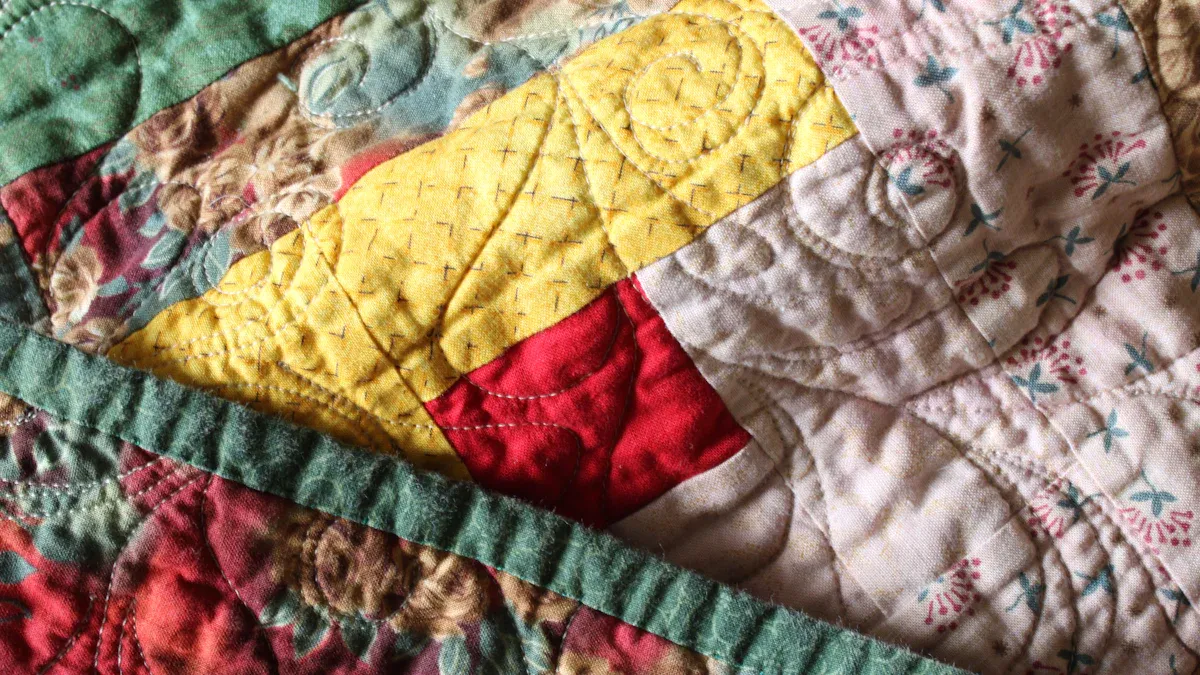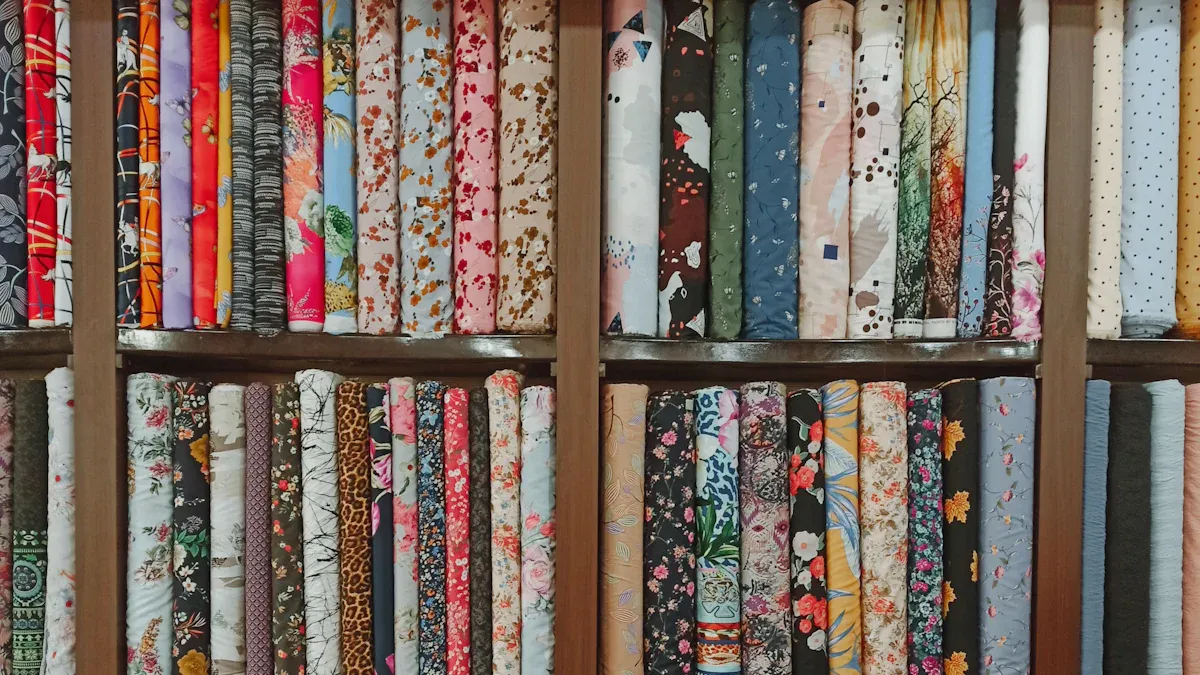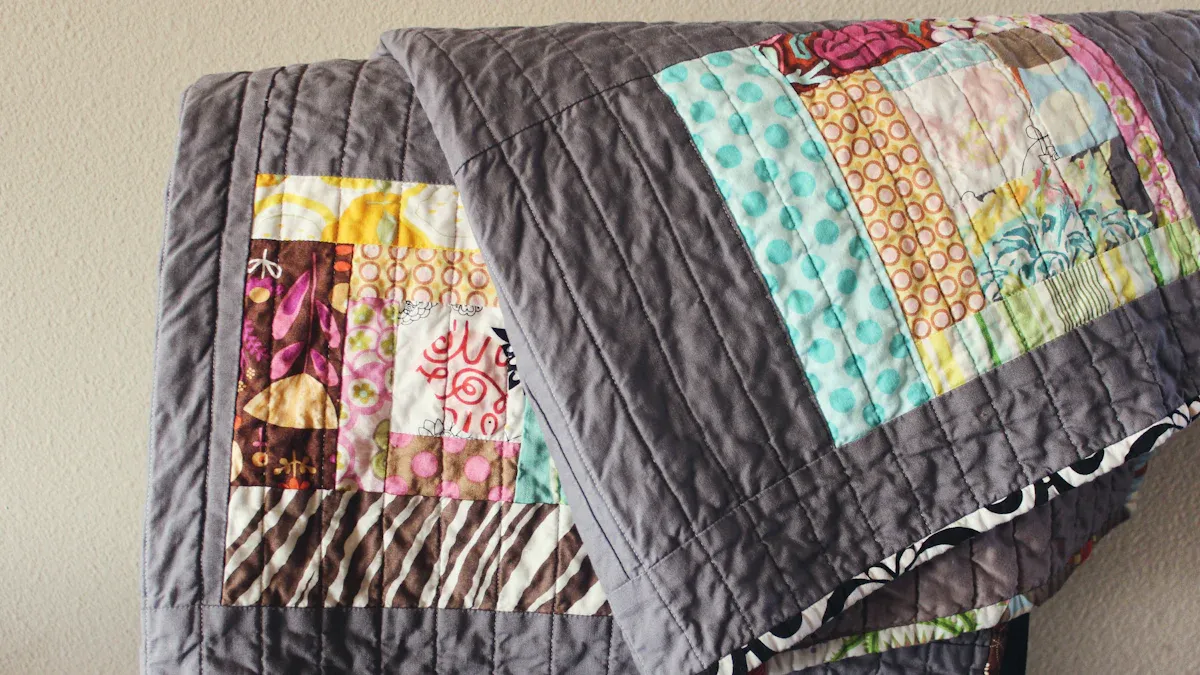
When you compare cotton poplin vs cotton for quilts, you want to find a fabric that feels soft, lasts through many washes, and is easy to work with. Cotton poplin stands out because its tightly woven construction stays durable and lightweight, while regular cotton brings breathability, comfort, and affordability.
Both options offer comfort and handle vibrant dyes well, so your quilt looks great and feels comfortable for daily wear. Fanda Fabrics gives you access to both cotton poplin and cotton fabrics, each with unique benefits for your next creative project.
Key Takeaways
Cotton poplin offers a crisp, smooth texture with a subtle ribbed feel, making quilts look modern and structured.
Regular quilting cotton feels soft and flexible, perfect for cozy, classic quilts and easy sewing.
Both fabrics are durable and hold color well, but poplin shrinks less and keeps its shape better over time.
Cotton poplin works great for machine quilting and sharp designs, while quilting cotton is forgiving for hand sewing and curves.
Mixing cotton poplin and quilting cotton in one quilt adds texture and interest, but prewash fabrics to avoid shrinkage and color issues.
Cotton Poplin vs Cotton

What Is Cotton Poplin?
When you pick up cotton poplin, you’ll notice how smooth and crisp it feels. This fabric stands out because of its unique weave. Poplin fabric uses a plain weave, but the yarns are of different sizes. The warp yarns are fine, while the weft yarns are thicker. This creates a subtle ribbed texture that you can feel if you run your fingers across the surface.
Cotton poplin is usually medium-weight cotton, making it strong but still breathable. You often see it in shirts, dresses, and even linings. After weaving, manufacturers might bleach, dye, or print the fabric to give it a fresh look or extra performance.
What Is Cotton Fabric?
Cotton fabric comes in many forms, but the most common type for quilting is called quilting cotton. This fabric uses a plain weave, just like poplin, but both the warp and weft yarns are the same thickness. That means you get a smooth, even surface without the ribbed effect.
Quilting cotton is usually medium-weight cotton, tightly woven, and easy to sew. You’ll find it in solid colors or fun prints, perfect for patchwork and other creative projects.
Some cotton fabrics blend in a bit of polyester for a smoother finish, but most quilting cotton is 100% cotton. The advantages of cotton include breathability, softness, and a high thread count that helps your quilts last.
Key Differences
Let’s break down the main differences in the cotton poplin vs cotton debate. Poplin fabric has a ribbed texture because of the thicker weft yarns, while regular cotton fabric feels smoother and more uniform. Poplin is denser, crisper, and often feels silkier to the touch.
It’s great for projects where you want clean lines and a bit of structure. Regular cotton, especially quilting cotton, is softer and holds its shape well, making it easier for patchwork and curved seams.
If you want a fabric that’s lightweight, smooth, and strong, cotton poplin is a solid choice. If you prefer something classic, soft, and easy to handle, regular cotton fabric might suit you better. The poplin vs cotton question really comes down to the feel and finish you want for your quilt.
Comparison of Cotton and Poplin
When you start a new quilt, the fabric you choose shapes the whole experience. Let’s break down the comparison of cotton and poplin so you can pick the best material for your next project.
Feature | Quilting Cotton Fabric | |
|---|---|---|
Durability | High, tightly woven, resists wear | High, strong weave, holds up to use |
Texture & Feel | Crisp, smooth, subtle ribbing, structured | Soft, smooth, flexible, classic cotton feel |
Ease of Sewing | Less stretch, easy to piece, crisp edges | Forgiving, easy for curves and hand sewing |
Care & Maintenance | Shrinks less, holds color, easy to wash | May shrink more, easy care, colorfast |
Drape | Structured, holds shape, less fluid | Softer, more flexible, drapes gently |
Best For | Modern, geometric, bold quilts | Patchwork, traditional, curved designs |
Tip: Fanda Fabrics offers both Cotton Poplin Fabric and Solids Cotton Fabric, so you can find the perfect match for your quilting style and needs.
Durability for Quilts
You want your quilt to last for years, so durability matters. Cotton poplin stands out because of its dense weave. This makes it tough and able to handle lots of use and washing. Quilting cotton is also strong, thanks to its high thread count and tight weave.
Both fabrics resist wear, but poplin fabric feels a bit sturdier and holds up well to daily use. If you want a quilt that keeps its shape and looks crisp, poplin is a great choice. Regular cotton fabric, especially high-quality quilting cotton, offers long-lasting performance and is a classic favorite for heirloom quilts.
Texture and Feel
The final feel of the quilt depends a lot on the fabric you pick. Cotton poplin gives you a crisp, smooth surface with a subtle ribbed texture. It feels structured and holds clean lines, which works well for modern or geometric quilts. Quilting cotton, on the other hand, feels softer and more flexible.
It drapes gently and feels cozy, making it perfect for snuggling. If you love a quilt that feels soft and classic, quilting cotton is the way to go. If you want a quilt that looks sharp and modern, poplin fabric delivers that structured finish.
Cotton poplin is denser and stiffer, so your quilt will have a more structured drape.
Poplin holds straight lines well, making it ideal for bold designs.
Quilting cotton offers a softer, more forgiving drape, which is great for curved piecing and hand stitching.
Mixing poplin and quilting cotton in one quilt can work, but you’ll want to pre-wash and maybe use stabilizers to balance the differences.
Ease of Sewing
Sewing with cotton poplin and quilting cotton both have their perks. Poplin fabric has less cross-grain stretch, so it’s easier to piece and keeps its shape as you sew. This makes it a favorite for machine quilting and for projects where you want crisp, straight seams.
Some quilters say hand sewing through poplin is just a bit tougher than regular cotton, but using a fine needle helps. Poplin can unravel at the edges, so finishing your seams is important. Quilting cotton is more forgiving, especially for curves and hand stitching. It’s a classic choice for beginners and experienced quilters alike.
Cotton poplin is easy to handle and reduces stretching during sewing.
Hand sewing bindings on poplin is only a little harder than on regular cotton.
Both fabrics can fray, so finishing raw edges with zigzag stitching or pinking shears helps keep your quilt looking neat.
Poplin doesn’t stretch much, so you don’t have to worry about your quilt losing shape.
Care and Maintenance
You want your quilt to stay beautiful wash after wash. Both cotton poplin and quilting cotton are easy to care for, but there are a few things to keep in mind. Poplin’s tight weave means it shrinks less than regular cotton, especially if it’s been treated by the manufacturer.
Still, it’s smart to pre-wash your fabric before quilting to avoid surprises later. Wash your finished quilt in cold water on a gentle cycle with mild detergent. Tumble dry on low heat and iron with a warm iron if needed.
Turning your quilt inside out before washing helps keep colors bright. Both fabrics hold color well, especially when you follow these care tips.
Machine wash cotton poplin cool with like colors.
Tumble dry on low heat.
Iron warm using a pressing cloth if needed.
Quilting cotton may shrink a bit more, but gentle washing and drying help control this.
Both fabrics keep their color best when washed in cold water and dried on low heat.
Note: Fanda Fabrics’ Cotton Poplin Fabric and Solids Cotton Fabric are both designed for easy care and lasting quality, so you can enjoy your quilt for years to come.
Best Cotton for Quilting

Patchwork Performance
When you start a patchwork quilt, fabric choice makes a big difference. Quilting cotton is a favorite because it is sturdy, easy to cut, and resists fraying. Cotton poplin also works well for patchwork, especially if you want crisp lines and a smooth finish.
Printed cotton adds personality and color to your quilt blocks. Here’s a quick look at popular patchwork fabrics and why quilters love them:
Fabric Type | Key Characteristics | Reasons for Popularity |
|---|---|---|
Quilting Cotton | Plain weave, stable, easy to handle | Versatile, wide color/print range, durable |
Cotton Poplin | Smooth, crisp, tightly woven | Holds shape, sharp lines, easy to sew |
Printed Cotton | Soft, colorful, many patterns | Adds style, easy to mix and match |
Batik | Tightly woven, slightly stiff | Resists fraying, softens with use |
Flannel | Soft, thick, warm | Great for baby quilts, cozy feel |
If you want the best cotton for quilting, try mixing solids and prints from Fanda Fabrics. Their quality fabrics make your patchwork stand out.
Machine vs Hand Quilting
You might wonder which fabric works best for machine or hand quilting. Cotton poplin is strong and wrinkle-resistant, so it glides through a sewing machine and keeps its shape. Quilting cotton feels softer and is easy to stitch by hand or machine.
Printed cotton gives you endless design options for both methods. If you want a quilt that looks crisp and modern, poplin is a great pick. For a softer, classic look, stick with quilting cotton. Both types from Fanda Fabrics offer high quality and easy care.
Tip: Cotton poplin is lightweight and durable, making it perfect for machine quilting. Quilting cotton is forgiving and soft, ideal for hand quilting or when you want a cozy finish.
Mixing Fabrics in a Quilt
Mixing cotton poplin and regular cotton in one quilt can give you an interesting texture and dimension. To get the best results, prewash all your fabrics to avoid shrinkage and color bleeding.
Use a little starch before cutting and sewing to keep everything crisp. Adjust your stitch length based on fabric weight. If you use both poplin and quilting cotton, press your seams well for a neat finish. Fanda Fabrics offers customization, so you can match colors and prints for a unique quilt.
Prewash all fabrics before starting.
Use starch for crisp cutting and sewing.
Adjust the stitch length for different fabric weights.
Press seams flat for a polished look.
Fanda Fabrics gives you the freedom to mix and match, so your quilt reflects your style. Their wide range of cotton poplin, solids, and printed cotton lets you create a quilt that is truly your own.
Choosing Quilt Fabrics
When you pick fabric for your next quilt, think about what matters most to you. If you want crisp lines and lasting structure, cotton poplin works well. For a softer touch and classic comfort, regular cotton is a great choice.
Try Fanda Fabrics’ cotton poplin or cotton collections to match your style. You can create a quilt that feels just right for you.
FAQ
What is the main difference between cotton poplin and regular cotton for quilting?
Cotton poplin feels crisp and smooth with a subtle ribbed texture. Regular quilting cotton feels softer and more flexible. Poplin gives your quilt a structured look, while regular cotton creates a cozy, classic feel.
Can I mix cotton poplin and regular cotton in one quilt?
Yes, you can! Just prewash both fabrics first. This helps prevent shrinkage and color bleeding. Mixing them adds texture and interest to your quilt. Press your seams well for a neat finish.
Does cotton poplin shrink after washing?
Cotton poplin may shrink a little, especially on the first wash. Prewash your fabric before you start sewing. Use cold or lukewarm water and dry on low heat to keep shrinkage to a minimum.
Is cotton poplin harder to sew than regular cotton?
Not really. Cotton poplin holds its shape and doesn’t stretch much, so it’s easy to sew straight seams. You might find it a bit crisper than regular cotton, but a sharp needle makes sewing smooth.
Which fabric is best for beginners?
Quilting cotton is a great choice if you’re just starting out. It’s soft, easy to handle, and forgiving. Cotton poplin works well too, especially if you want a modern, structured quilt. Try both and see which you like best!
